Vision 2025 - National Research Centre for Grapes
Vision 2025 - National Research Centre for Grapes
Vision 2025 - National Research Centre for Grapes
You also want an ePaper? Increase the reach of your titles
YUMPU automatically turns print PDFs into web optimized ePapers that Google loves.
15. OUTPUTS (ANTICIPATED OUTPUTS OF TECHNOLOGIES,<br />
PUBLICATIONS, PATENTS)<br />
Proposed research programme on management of grape genetic resources is expected to result in the<br />
augmentation of wide grape genetic diversity available in the country with the help of conventional<br />
and biotechnological tools. Core germplasm will be identified through conventional and molecular<br />
marker tools and maintained <strong>for</strong> posterity. The germplasm evaluation will pinpoint the genetic<br />
sources <strong>for</strong> resistance and tolerance to abiotic and biotic resistance as well as other horticulturally<br />
important traits This will provide the basic in<strong>for</strong>mation needed to <strong>for</strong>mulate the breeding strategies<br />
and identify donors <strong>for</strong> various traits. Molecular marker techniques will result in developing easy and<br />
simpler tools <strong>for</strong> progeny selection in breeding program as well as gene pyramiding. The programme<br />
will also result in identification of the most promising new genotypes <strong>for</strong> different climatic<br />
conditions in the country <strong>for</strong> various end uses.<br />
The research is expected to yield patents and / or plant variety protection of commercial varieties of<br />
different end uses, molecular markers, new genes that can be exploited commercially to generate<br />
revenue possibly by exclusive marketing rights <strong>for</strong> the patented plant materials.<br />
<strong>Research</strong> programmes on nursery technology, rootstocks, training system, management of canopy,<br />
and use of bioregulators is expected to result in better technologies <strong>for</strong> quality grape production with<br />
least environment disturbances. Technologies <strong>for</strong> production of quality planting material will ensure<br />
genetic uni<strong>for</strong>mity and freedom from pests and diseases, which will subsequently result in<br />
homogeneity in plants and healthy vineyards. Most suitable rootstocks <strong>for</strong> commercial table and<br />
wine varieties <strong>for</strong> different edaphic and agroclimate zones will provide an opportunity to expand the<br />
grape production in new areas and sustain production under drought and salinity conditions. Variety<br />
specific training systems, canopy architecture and cultivation techniques like plant density and use<br />
of bio regulators will help in optimizing yield and quality with minimum input costs.<br />
Assessment of water requirement of different table and wine varieties will help in rationalizing the<br />
water use under scarcity conditions. Development of petiole nutrient guides and technologies related<br />
to fertigation and nutrient sources will help in application of appropriate nutrient in most suitable<br />
<strong>for</strong>m in optimum dose at the required growth stage <strong>for</strong> all commercially important stock-scion<br />
combinations <strong>for</strong> both table and wine varieties. Integrated nutrient management by in situ recycling<br />
and use of cover-crops and efficient strains of biofertilizer will help in maintaining soil fertility and<br />
reduce use of chemical nutrients. Technologies <strong>for</strong> managing physiological and nutrient disorders<br />
and protected cultivation will further help in improving quality and minimizing losses and risk in<br />
cultivation. Designs of farm implements and accessories <strong>for</strong> various vineyard operations, if<br />
developed will be patented to exploit commercially.<br />
<strong>Research</strong> programmes on management of diseases and insect pest and management of pesticide<br />
residues will result in development of technologies <strong>for</strong> pest management in table and wine grape<br />
varieties with minimum pesticide use. <strong>Research</strong> will identify new generation, safe molecules,<br />
biological, botanicals and environment friendly technologies <strong>for</strong> pest management. Studies on<br />
farmer friendly disease <strong>for</strong>ecasting systems / modules, epidemiology and seasonal incidence of<br />
important pests of grape will help in scheduling pesticides sprays. Studies on MRL and PHI will<br />
guide the farmers on safe use of pesticides. Bioremediation by beneficial microorganisms can be<br />
used <strong>for</strong> reducing the PHI of unavoidable pesticide sprays be<strong>for</strong>e harvest and avoid risk of rejection<br />
of the produce by end users. Survey to monitor the emergence of new pests and diseases will avoid<br />
flaring up their population / level to economically damaging levels.<br />
39





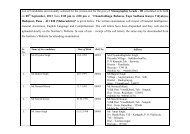
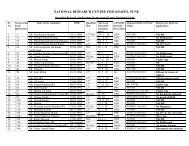

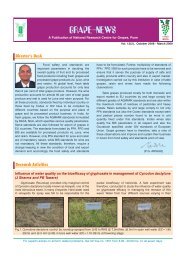

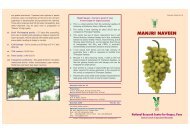
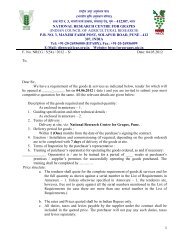



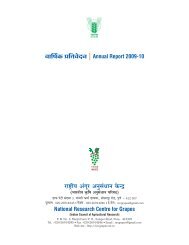
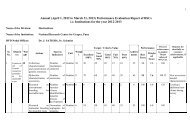
![mj]mJ{V cmcH$m{irM{ (_mBQâ¤>g) oZ`ÃÃU](https://img.yumpu.com/33367555/1/190x127/mjmjv-cmchmirm-mbqag-ozaau.jpg?quality=85)